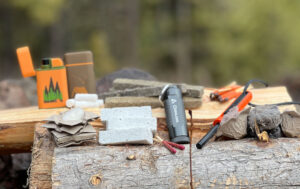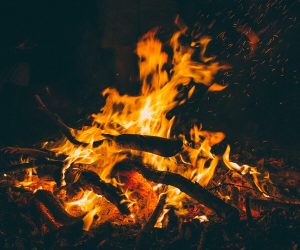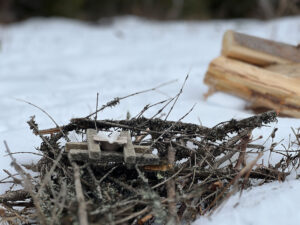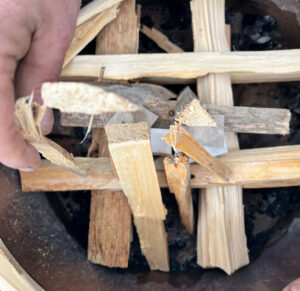
Image by Suzanne Downing
When you’re camping, weather is unpredictable at times. The skills to start a fire in varying weather conditions are good to have. And having the right materials to build a fire can make or break your campfire. Whether you’re camping in a forest of pines, hiking across snowy valleys or navigating gentle rain showers in a campground, the warmth and comfort of a crackling fire can add to your camping experience. In some cases, a campfire can also become a lifeline and a beacon of safety.
In this guide, you’ll learn the basics of building and sustaining a fire in wind, snow and light rain.
Basic Materials
Before you head out to your destination, be sure to have some basic fire-starting supplies with you. Here is a list of materials used commonly among campers — including the materials used in the instructions below for starting a fire in each weather condition.

Image by Suzanne Downing
Igniters: Stormproof matches, MK Small Torch Lighter, ferrocerium fire starter
Tinder: Lint from dryer, Fast Fire fire starters, fire sticks, water-resistant tinder, cardboard egg carton pieces
Kindling: Small sticks, chopped wood pieces
Fuel: Logs
Having basic fire-starting supplies and gathering wood prior to attempting to build and light a campfire will set you up for success. And understanding the roles of tinder, kindling, and fuel is fundamental to mastering this essential outdoor skill.
Tinder, often composed of small materials like dryer lint, cotton balls, or fire sticks, serve as the initial ignition point. While dry leaves may seem promising, they tend to smolder rather than ignite. Pine needles are much better than leaves, if available.

Kindling, the intermediary between tinder and fuel, consists of medium-sized materials such as sticks and twigs. Optimal kindling is dry and brittle, snapping easily when handled. Green kindling or overly decayed wood holds moisture, hindering combustion. If a stick crumbles in your hand, it’s decayed. You can gather sticks and twigs in most outdoor spaces, but if not recommended, making kindling from pre-brought logs allows for customization — ensuring a well-organized progression from small to large pieces.
“Fuel” is your logs. Once you’ve successfully ignited flames using your igniter of choice, tinder and kindling, your logs will fuel your fire. Typically logs at least 3 inches in diameter are best.
Bottom line: When you light that first match, have everything you need right there.
Windy Conditions
When you encounter windy conditions, have a wind barrier around your fire area. This can be stacked logs, rocks or you can move your body to block the wind. Start by looking for a fire pit already made by previous campers. If you can’t find one, dig your own shallow hole and gather some rocks to build a designated fire pit area.
Once you have a fire pit, arrange small twigs in a pyramid shape on the ground inside your fire pit. Place a handful of dryer lint from your supply and a stormproof match in the center of your pyramid at the bottom.

Image by Suzanne Downing
Next, use a torch lighter to light your stormproof match. Once the twigs catch fire, add more dry twigs gradually to feed the flame. Continue to shield the flame with your body or move your wind barrier as needed. As the fire grows, add larger pieces of wood, alternating between thicker twigs and small logs. From here, you should be able to maintain a steady fire.
Winter (Cold & Snow) Conditions
When you’re ready to build your campfire in snowy conditions, look for a flat area of ground. Create a base layer over the snow using a grouping of small twigs. Next, grab some fire sticks from your supply and stack them in a log cabin style. Add a couple water-resistant tinder swabs (broken apart) and place them in a cardboard egg carton piece on top of your fire sticks.

Image by Suzanne Downing
Use a ferrocerium rod to generate sparks onto the tinder swabs until they ignite. Use medium pressure and strike fast. Once the tinder and fire sticks catch fire, place another section of your cardboard egg carton on top and begin to add small twigs. You’ll notice you have sustained heat. Continuously feed your fire with dry wood to maintain warmth and prevent it from extinguishing due to the cold temperatures.
Light Rain Conditions
When you have a fire pit at a campground, here is one way to start a fire in light rain conditions.
Inside your fire pit, build a log cabin base with some of your kindling. This helps keep your wood off the bottom of your fire pit in the chance that it’s wet from the rain. Next build a small pyramid and place a couple of your fast fire blocks inside at the bottom of the pyramid but on top of your log cabin build.
Ignite your fast fire blocks with a stormproof match. These matches are ideal in light rainy conditions and will still ignite a flame regardless of moisture. Once the fast fire blocks catch fire, add more small twigs on top and gradually build up the flame. The pyramid acts as a makeshift shelter to keep rain at bay and keep your fast fire blocks burning consistently.

Image by Suzanne Downing
If you have an awning on your tent or RV, keep your logs under there so they stay dry. You can also cover your wood stack with a tarp and gather wood from your dry supply to add to your fire pit as needed. Dry wood will counteract the dampness and maintain a steady burn.
By following these steps and using the various materials recommended, you can effectively start and maintain a fire in different weather conditions. Always prioritize safety and proper fire management practices.
Suzanne Downing is an outdoor writer and photographer in Montana with an environmental science journalism background. Her work can be found in Outdoors Unlimited, Bugle Magazine, Missoulian, Byline Magazine, Communique, MTPR online, UM Native News, National Wildlife Federation campaigns and more.
 Your Privacy Choices
Your Privacy Choices
 The
The